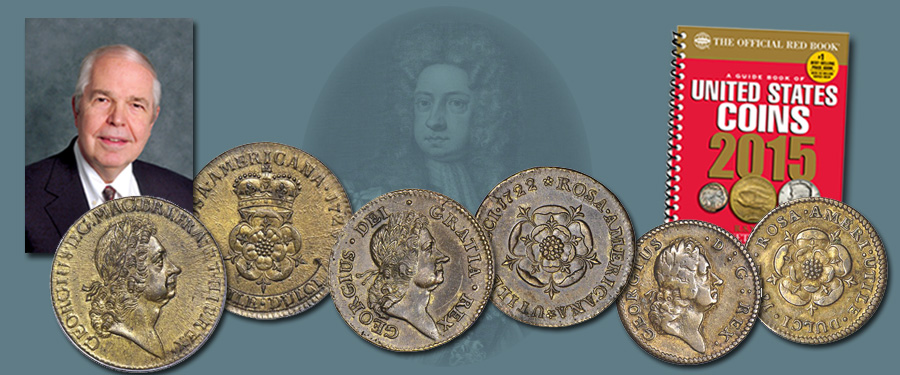
Last week I introduced the contract coinage of William Wood, a British entrepreneur who in 1722 obtained the patent or franchise from King George I to make coins for America. These were in the denominations of halfpenny, penny and twopence and were made of a new alloy. Striking was done with a drop press, in which the weighted top die traveled at high speed to impact the planchet resting on the bottom or anvil die, thus striking the coin. You can follow my discussion beginning on page 41 in the 2015 Guide Book of United States Coins.
The first issues of 1722, known as Rosa Americana pieces, bore that inscription on the reverse above a rose blossom, with the inscription UTILE DULCI below. This translates into “The American Rose: The Useful with the Sweet.” The inscriptions varied slightly in their placement and most issues were dated on the reverse. The obverse depicted a high relief portrait of King George, in Latin, GEORGIUS D:G MAG: BRI: FRA: ET. HIB: REX (George, by the Grace of God, King of Great Britain, France and Ireland). There was no Roman numeral after his name, as he did not become known as George I until a successor was listed as George II. Most Rosa Americana coins were dated 1722 or 1723. A few issued in 1724 are considered to be patterns.
Despite high hopes, the pieces were not well accepted in America. It was not for the lack of trying. On October 29, 1725, the Duke of Newcastle wrote to the governor of Massachusetts Bay enclosing a copy of the Wood agreement and requesting that the governor “give all the encouragement and assistance to have the pieces used in commerce.” Not much is known about their everyday circulation on this side of the Atlantic, but only a few pieces have ever been found by metal detectorists and others, where as such finds of Spanish-American silver, 1773-dated Virginia copper halfpence, and the like, are numerous. Most Rosa Americana coins in American cabinets were acquired from English sources since the 1850s, when coin collecting became widely popular in the United States.
The new alloy was not ideal for striking. Existing coins typically have bubbles, pinpoint “pock marks,” or cracks from the heating of the planchet prior to striking, and other irregularities. Many have file marks on the edge for trimming the planchet prior to striking. The color can vary, but most are of a yellow hue. High grade pieces do not have luster in the sense that coins struck in copper do, as the alloy was not suitable for creating such.
Today in 2015 Rosa Americana coins are very popular. The standard reference on the series is by Syd Martin, The Rosa Americana Coinage of William Wood, published in 2011. Syd, a prominent factor in the collecting of American colonial-related issues, is also the distinguished editor of the C4 Newsletter publication of the Colonial Coin Collectors Club. Syd has also done in-depth research on other series, creating volumes that tell just about anything readers might ever want to know about the title subject.
A typical collection of Rosa Americana pieces can be formed by studying those shown in the Guide Book on pages 42 and 43, acquiring one of each type, consisting of the undated twopence that heads the listing, followed by one each of the 1722 and 1723-dated halfpenny, penny and twopence. The issues dated 1724 and considered patterns are significantly more expensive and would not be considered part of a “basic set.” Additionally, there are different varieties, some of which demand a steep premium, that can be collected as well. A basic set is affordable for most collectors and is an interesting display.
I will see you next week, the subject being William Wood’s Hibernia coinage beginning on page 44 of the Guide Book.





